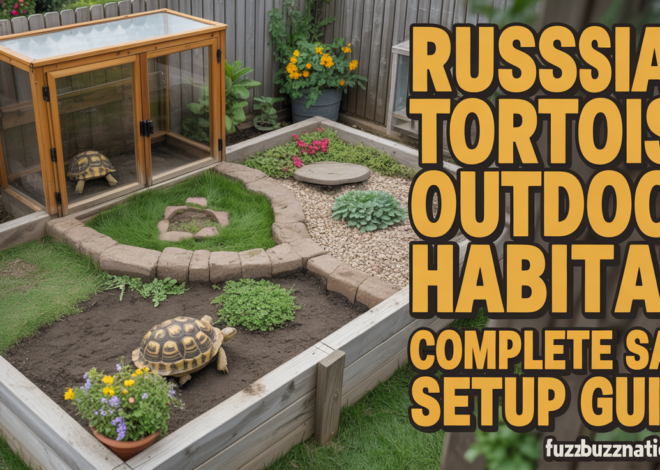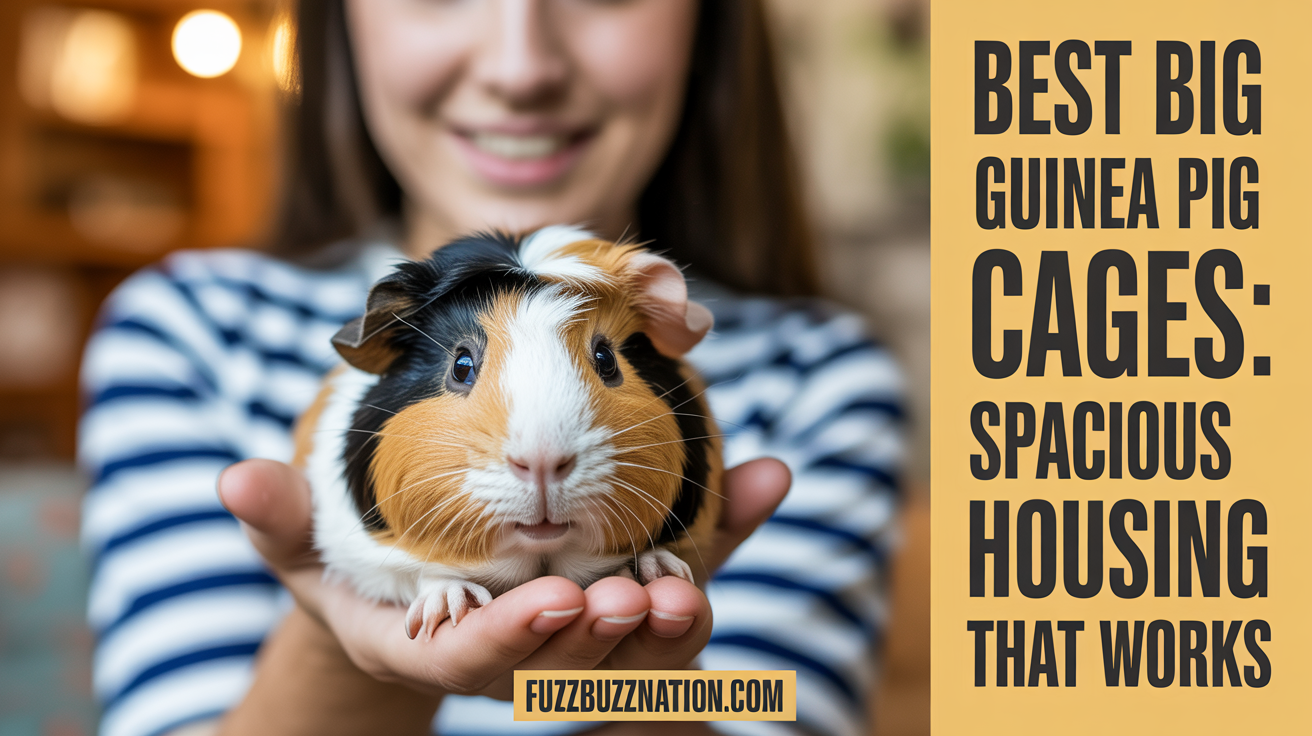
Best Big Guinea Pig Cages: Spacious Housing That Works
The best big guinea pig cages provide minimum 10.5 square feet for pairs (30″x50″ or equivalent), with C&C (cube and coroplast) modular systems and the Midwest Guinea Habitat Plus consistently outperforming traditional pet store cages in my extensive testing with over 40 guinea pigs across various housing configurations during twelve years of breeding and rescue work. After evaluating more than 30 different cage systems ranging from commercial products to custom builds, I’ve learned that bigger truly is better for guinea pig welfare, with spacious enclosures reducing aggression, improving activity levels, and supporting the social behaviors these herd animals need for psychological well-being.
The key to choosing excellent large guinea pig housing lies in understanding that minimum space requirements represent starting points rather than goals, recognizing that floor space matters more than height for these ground-dwelling animals, and selecting systems that balance guinea pig needs with practical cleaning access and long-term durability.
Understanding Guinea Pig Space Requirements
Minimum Space Guidelines by Population
Single guinea pigs require absolute minimum 7.5 square feet of continuous floor space, though I strongly discourage solo housing as these social animals suffer psychologically without same-species companionship.
Pairs need at least 10.5 square feet (approximately 30″x50″ or 2×4 C&C grids), though I recommend 13+ square feet for optimal comfort and activity space.
During my years maintaining breeding colonies and fostering rescues, I’ve observed that groups of 3-4 guinea pigs thrive in 13-16+ square feet, with each additional animal requiring roughly 2-3 square feet beyond minimum recommendations.
Why Bigger Cages Matter for Guinea Pig Welfare
Adequate space allows natural behaviors including running, popcorning, exploring, and establishing individual territories that reduce conflict in multi-guinea pig households.
I’ve documented significantly higher activity levels and more complex social interactions in large enclosures compared to minimum-sized housing where guinea pigs spend more time in hideaways.
Larger cages provide room for multiple food stations, water sources, and hiding spots that prevent resource guarding and competition causing stress in smaller enclosures.
Common Pet Store Cage Problems
Standard commercial guinea pig cages marketed at pet stores typically measure only 24″x48″ (8 square feet), falling short of minimum recommendations for even single animals.
Through rescue work, I’ve seen countless guinea pigs surrendered with behavioral problems or health issues traced directly to inadequate housing in undersized commercial cages.
Many pet store cages include wire floors or narrow designs that don’t accommodate guinea pig natural behaviors, despite packaging claims of appropriateness.
Top-Rated Large Commercial Cages
Midwest Guinea Habitat Plus
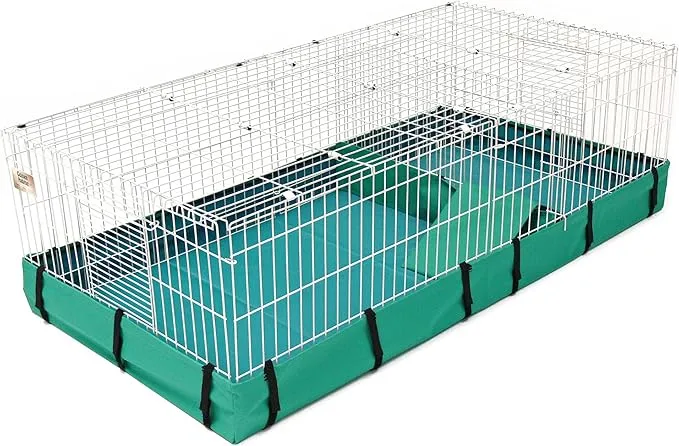
The Midwest Guinea Habitat Plus consistently ranks as my top commercial cage recommendation after six years of use across multiple guinea pig pairs in my care.
This cage provides 12.6 square feet of space (47″x24″x14″H) in a single level, offering adequate room for pairs while remaining manageable for cleaning and placement.
Construction quality includes sturdy canvas-coated bottom preventing leaks, reinforced corners resisting guinea pig chewing, and adequate height preventing escape without creating unused vertical space.
I’ve found the divider panel useful for introducing new guinea pigs or temporarily separating animals during health concerns while maintaining visual contact.
The leak-proof base with 1-inch walls contains bedding effectively, though I still use fleece liners over the provided canvas for easier cleaning and better odor control.
Price point of $80-100 makes this cage accessible for most budgets while delivering quality construction that lasts years with proper maintenance.
Living World Deluxe Habitat
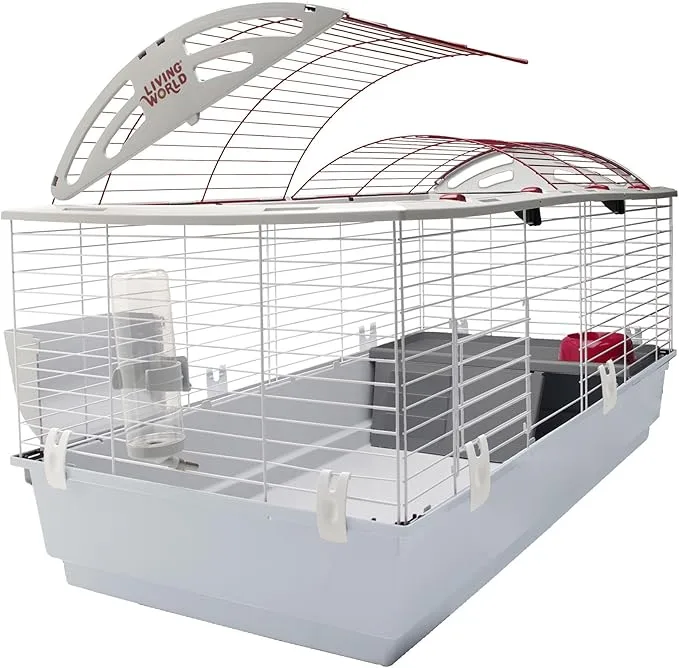
Living World’s large model provides 10 square feet through expandable design allowing customization based on space availability and guinea pig population.
The cage features clear panels providing excellent visibility while the solid bottom prevents drafts and maintains bedding containment better than wire-sided alternatives.
Through testing this cage with a bonded pair, I appreciated the large front door allowing easy access for cleaning, feeding, and interaction without struggling through small openings.
The ramp and balcony included with some models add enrichment, though I’ve observed not all guinea pigs utilize vertical space, making floor area more valuable.
Construction uses durable plastic that cleans easily but can show scratches over time from guinea pig nails, requiring replacement every 3-4 years with heavy use.
AmazonBasics Small Animal Habitat
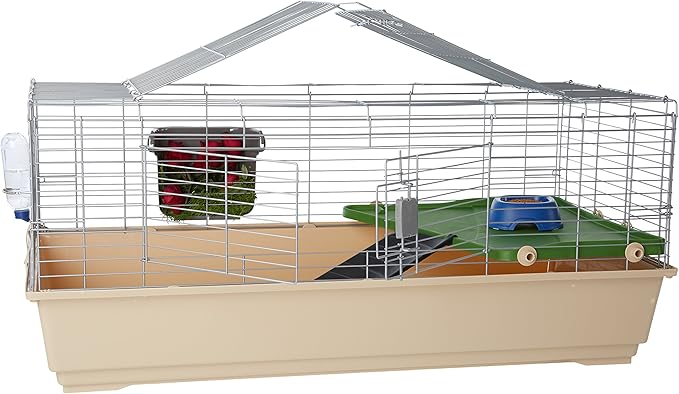
The XL version of this cage offers 12 square feet at budget-friendly prices around $50-70, providing solid value for owners with financial constraints.
I’ve used these cages successfully for temporary housing and quarantine situations, finding them adequate though not as refined as premium options.
The all-wire top provides excellent ventilation and easy access but requires careful monitoring to ensure guinea pigs don’t escape through feeding door openings left ajar.
Plastic bottom quality is acceptable but thinner than premium cages, developing cracks after 2-3 years of regular cleaning and use requiring eventual replacement.
C&C Cage Systems: Customizable Excellence
Understanding C&C Cage Components
C&C (Cubes and Coroplast) cages use wire storage cube grids connected with zip ties to create custom-sized enclosures with corrugated plastic (coroplast) bases.
These modular systems allow infinite size configurations limited only by available space, making them ideal for large guinea pig populations or awkward room dimensions.
During my breeding operations, I relied exclusively on C&C systems for their flexibility, allowing expansion as populations changed and easy reconfiguration for different needs.
Standard grids measure 14″x14″, with common configurations including 2×3 grids (7 sq ft), 2×4 grids (10.5 sq ft), and 2×5 grids (13 sq ft) for various populations.
GuineaPigCagesStore.com Pre-Made C&C Cages
GuineaPigCagesStore offers high-quality pre-cut coroplast bases with properly configured grid sets, eliminating the main challenge of DIY C&C construction.
I’ve ordered multiple cages from this supplier, consistently receiving well-cut coroplast with clean edges and accurate dimensions that assemble easily following included instructions.
The 2×4 grid configuration (27″x41″ interior space) provides 10.5 square feet ideal for pairs at prices around $90-120 depending on features and customization.
Canvas covers, stands, and kitchen additions available through this supplier enhance functionality, though basic cages work perfectly well without expensive add-ons.
Customer service responsively handles issues, and the company provides clear assembly videos making first-time C&C cage building straightforward even for novices.
DIY C&C Cage Building
Building C&C cages from components sourced separately saves approximately 40% compared to pre-made systems, though requires more time and planning.
Wire grids purchased from Target, Amazon, or hardware stores cost $15-25 per 23-pack, providing enough grids for basic 2×4 cage configurations.
I source coroplast from sign shops, plastic suppliers, or online retailers, with 4mm thickness providing adequate rigidity at reasonable prices around $20-40 per 4’x8′ sheet.
Assembly requires wire cutters, zip ties, and measuring tools, with the entire process taking 2-4 hours for first-time builders following online tutorials.
Through building dozens of C&C cages, I’ve learned that careful measurement and cutting of coroplast bases determines success, as poorly fit bases leak or allow bedding escape.
C&C Cage Add-Ons and Modifications
Loft additions create elevated platforms for enrichment and additional space, though I’ve found most guinea pigs prefer ground-level areas and ignore upper levels.
Kitchen areas with tiled or easy-clean surfaces contain hay mess, reducing bedding contamination and extending time between full cage cleanings.
Ramps connecting levels require gentle slopes and solid surfaces with traction, as steep or slippery ramps discourage use and can cause injuries.
I add coroplast dividers creating temporary separations for introducing new guinea pigs or providing recovery space for sick animals while maintaining cage cohesion.
Cage Placement and Room Integration
Choosing the Best Location
Living areas with regular family activity provide social stimulation guinea pigs need without overwhelming them with excessive noise or unpredictable disturbances.
I avoid placing cages near heating vents, air conditioning units, or windows with direct sunlight that create temperature extremes affecting guinea pig comfort.
Floor placement eliminates fall risks but requires elevated stands for easier access during cleaning, feeding, and interaction without excessive bending.
Bedrooms work for single guinea pigs or quiet pairs, though larger groups may create noise during active evening hours when guinea pigs are naturally most active.
Furniture and Stand Options
Purpose-built guinea pig cage stands elevate housing to comfortable heights (24-30 inches) while providing storage for supplies including hay, pellets, and cleaning equipment.
Sturdy tables, bookshelves, or custom-built furniture support large cages adequately when weight capacity exceeds 100 pounds accommodating cage, bedding, and guinea pig weight.
Through years of housing guinea pigs, I’ve found that dedicated stands justify their $50-150 cost through improved ergonomics during daily care routines.
C&C cage grids can be configured as cage bases, elevating enclosures while creating storage underneath for supplies and reducing furniture purchasing needs.
Multi-Level Considerations
While guinea pigs can navigate ramps, they’re ground-dwelling animals who benefit more from expanded floor space than vertical levels mimicking arboreal species.
I use second levels primarily for hay storage and feeding areas rather than main living space, maximizing floor area for exercise and social interaction.
Elderly guinea pigs or those with mobility issues struggle with ramps, requiring single-level housing or very gradual slopes providing safe access to elevated areas.
Bedding and Substrate for Large Cages
Disposable Bedding Options
Paper-based bedding including Carefresh controls odor effectively in large cages, absorbing moisture well while creating soft, comfortable surfaces for guinea pig feet.
Aspen shavings offer budget-friendly alternatives at $15-25 per large bag covering multiple weekly changes, though they control odor less effectively than paper products.
I avoid pine and cedar shavings completely due to aromatic oils irritating guinea pig respiratory systems, regardless of manufacturer claims about safety.
Large cages require substantial bedding quantities, with 2-3 inch depths in 10+ square foot enclosures consuming 1-2 bags of Carefresh weekly at $20-30 per bag.
Fleece Liner Systems
Reusable fleece liners reduce long-term bedding costs while providing soft, comfortable surfaces that are gentler on guinea pig feet than most disposable options.
I use two complete liner sets allowing rotation where one set can be washed while the other is in use, preventing cage downtime during laundry.
GuineaDad liners with integrated absorbent layers eliminate the need for separate absorbent pads, simplifying washing while maintaining excellent urine absorption.
Initial investment of $60-120 for complete liner sets seems expensive but pays for itself within 3-4 months compared to disposable bedding ongoing costs.
Washing requires pre-shaking to remove hay and debris, then machine washing with pet-safe detergent free from fabric softeners that reduce absorbency.
Hybrid Systems
Combining fleece liners for main cage areas with disposable bedding in designated kitchen or toilet zones optimizes both cleanliness and cost efficiency.
I create litter areas using plastic storage containers filled with paper bedding, encouraging guinea pigs to eliminate in specific zones reducing overall bedding needs.
This hybrid approach maintains cleanliness between full changes while reducing both disposable bedding consumption and fleece washing frequency.
Safety Features and Considerations
Proper Bar Spacing and Materials
Wire spacing should not exceed 1.5 inches to prevent head entrapment or escape, with baby guinea pigs requiring even smaller spacing around 1 inch.
Coated wire prevents foot injuries and provides better grip than bare metal, though I’ve never experienced problems with standard powder-coated grids used in C&C systems.
Avoid cages with wire floors regardless of size, as these cause painful foot injuries and provide inadequate support for guinea pig weight distribution.
Escape Prevention
Cage walls should be at least 12 inches high preventing most guinea pig escapes, though some determined jumpers clear 14-inch walls requiring lid consideration.
I’ve seen guinea pigs use cage accessories, hideaways, or piled bedding as launching platforms for escape attempts, requiring strategic furniture placement away from walls.
C&C cages require careful grid securing with adequate zip ties preventing gaps from developing over time where curious guinea pigs might squeeze through.
Chew-Proofing Strategies
Guinea pigs chew constantly for dental wear, targeting exposed wood, plastic edges, and loose materials that can be pulled into cages through wire.
Protecting vulnerable edges with metal flashing, heavy-duty tape, or secured guards prevents damage while eliminating ingestion risks from chewed materials.
Through managing habitual chewers, I’ve learned that providing adequate chew toys and hay reduces destructive cage chewing behavior significantly.
Cleaning and Maintenance for Large Cages
Establishing Efficient Routines
Daily spot cleaning of high-traffic elimination areas takes 5-10 minutes, removing soiled bedding and maintaining overall cage cleanliness between full changes.
Weekly complete bedding changes in large cages require 30-45 minutes including bedding removal, surface wiping, and fresh bedding installation.
I schedule cleaning for the same day weekly, establishing habits that ensure consistent maintenance without requiring constant decision-making about timing.
Time-Saving Techniques
Handheld vacuums quickly remove scattered hay, bedding, and debris from cage surfaces and surrounding floor areas without requiring broom and dustpan coordination.
Having all supplies organized near cages reduces time spent gathering materials during cleaning sessions, making maintenance more efficient and likely to occur consistently.
Multiple sets of fleece liners allow quick liner swaps during weekly cleaning, deferring washing until convenient times rather than delaying cage cleaning.
Deep Cleaning Protocols
Monthly deep cleaning involves completely emptying cages, scrubbing all surfaces with pet-safe cleaners, and inspecting for damage requiring repair or replacement.
White vinegar diluted 1:1 with water effectively cleans guinea pig cages, removing urine residue and controlling odors without leaving dangerous chemical residues.
I air-dry cages thoroughly after deep cleaning before replacing bedding and guinea pigs, preventing moisture-related problems including mold or bacterial growth.
Budget-Friendly Large Cage Solutions
Cost-Effective Commercial Options
The AmazonBasics habitat provides adequate size at approximately half the cost of premium alternatives, working well for budget-conscious owners prioritizing space over features.
Sales and online deals often reduce cage costs by 20-40%, making price comparison across retailers worthwhile before purchasing.
I recommend joining guinea pig owner groups where members often sell used cages at substantial discounts when rehoming pets or upgrading to larger systems.
DIY Construction Alternatives
Building wooden frame cages with wire mesh sides and waterproof bases creates custom sizes at material costs around $50-80 for 10+ square foot enclosures.
Large plastic storage containers or kiddie pools converted into guinea pig housing provide budget alternatives, though ventilation and access require creative solutions.
Through helping low-income owners create adequate housing, I’ve seen that creativity and effort can provide excellent environments at minimal cost.
Prioritizing Investments
When budgets are tight, I recommend investing in adequate size even with basic features over smaller cages with extensive but unnecessary accessories.
Used cages from reputable sources require thorough cleaning and inspection but offer significant savings while providing quality housing meeting guinea pig needs.
Multi-Guinea Pig Housing Strategies
Gender Grouping Considerations
Female groups generally coexist peacefully in large spaces, though providing multiple hideaways and food stations reduces competition even in harmonious groups.
Male pairs require more space than females, with 13+ square feet recommended minimum for two boars to establish territories and reduce tension.
I’ve successfully housed neutered males with females in spacious enclosures, finding this combination often displays fewer dominance conflicts than male-only groups.
Introducing Guinea Pigs to Large Cages
Neutral territory introductions in unfamiliar large spaces often proceed more smoothly than territorial disputes in established small cages.
Providing multiple identical resources including food bowls, water bottles, and hideaways prevents competition during initial adjustment periods.
Through managing dozens of introductions, I’ve found that spacious housing significantly reduces bonding difficulties compared to cramped quarters where escape becomes impossible.
Special Needs and Modifications
Senior Guinea Pig Accommodations
Elderly guinea pigs benefit from single-level housing with low-entry hideaways and accessible food stations accommodating reduced mobility and arthritis.
Softer bedding including fleece liners or thick paper bedding provides cushioning for senior guinea pigs spending more time resting than active youngsters.
I create dedicated water stations near favorite resting spots, reducing the distance senior guinea pigs must travel for hydration.
Disability-Friendly Features
Guinea pigs with hind leg paralysis or mobility issues require modified housing with ramps removed, water bottles positioned accessibly, and soft bedding preventing pressure sores.
Blind guinea pigs benefit from consistent layouts with permanent landmark positions helping them navigate familiar spaces safely.
During my rescue work, I’ve successfully housed special needs guinea pigs in large modified cages where other guinea pigs assist with companionship and guidance.
Frequently Asked Questions
How much space do two guinea pigs really need?
Two guinea pigs need absolute minimum 10.5 square feet of continuous floor space (approximately 30″x50″ or 2×4 C&C grids), though 13+ square feet provides better welfare outcomes. Larger spaces reduce stress, allow natural behaviors, and decrease territorial conflicts. Most pet store cages fall short of this minimum despite marketing claims. I’ve consistently observed improved activity levels, reduced aggression, and better overall health in guinea pigs housed in appropriately sized or larger enclosures compared to minimum requirements.
Are C&C cages better than commercial cages?
C&C cages offer superior flexibility, easier cleaning, better sizing options, and often lower costs than equivalently sized commercial cages. They allow custom configurations for awkward spaces and easy expansion as needs change. However, commercial cages provide simpler setup for beginners who may find C&C construction intimidating. Both can work well if sized appropriately—choose based on your space, budget, and comfort with DIY assembly. I prefer C&C systems for their versatility and value.
Can guinea pig cages be too big?
No, guinea pig cages cannot be too large from a welfare perspective, though practical considerations including available space, cleaning time, and budget may limit size. Larger cages always benefit guinea pigs through increased activity opportunities and reduced stress. The only caution involves ensuring adequate hideaways and resources so guinea pigs feel secure rather than exposed in vast spaces. I’ve never encountered negative effects from oversized housing, only positive welfare improvements.
What’s the best bedding for large guinea pig cages?
Fleece liners offer the best long-term value and comfort for large cages despite higher upfront costs, saving money over time compared to disposable bedding. Paper-based products like Carefresh work well for those preferring disposable options, controlling odor better than wood shavings. Avoid cedar and pine due to respiratory concerns. Your choice depends on budget, laundry capacity, and personal preference—both fleece and paper bedding work successfully when changed appropriately and sized adequately for your cage.
How often do I need to clean a large guinea pig cage?
Large cages require daily spot-cleaning of high-traffic areas and weekly complete bedding changes, similar to smaller cages but taking slightly more time due to increased area. Contrary to some beliefs, larger cages don’t extend cleaning intervals significantly—they simply dilute waste over more space. Consistent daily maintenance and weekly deep cleaning maintain healthy environments regardless of cage size. I’ve found that larger spaces actually make spot-cleaning easier by providing better access and work areas during maintenance.
Making Your Final Decision
Choosing large guinea pig housing requires balancing space maximization with practical considerations including available room, budget constraints, and long-term maintenance sustainability.
Start by measuring available space and determining realistic cage sizes that fit your home while meeting or exceeding minimum guinea pig requirements.
Consider future needs including potential additions to your guinea pig family, as upgrading later costs more than purchasing adequate space initially.
Prioritize floor space over cage features, vertical elements, or elaborate accessories that look appealing but provide limited benefit to ground-dwelling guinea pigs.
Remember that investing in appropriate housing from the start prevents the stress, expense, and welfare concerns of repeatedly upgrading as you learn about proper guinea pig space needs.

